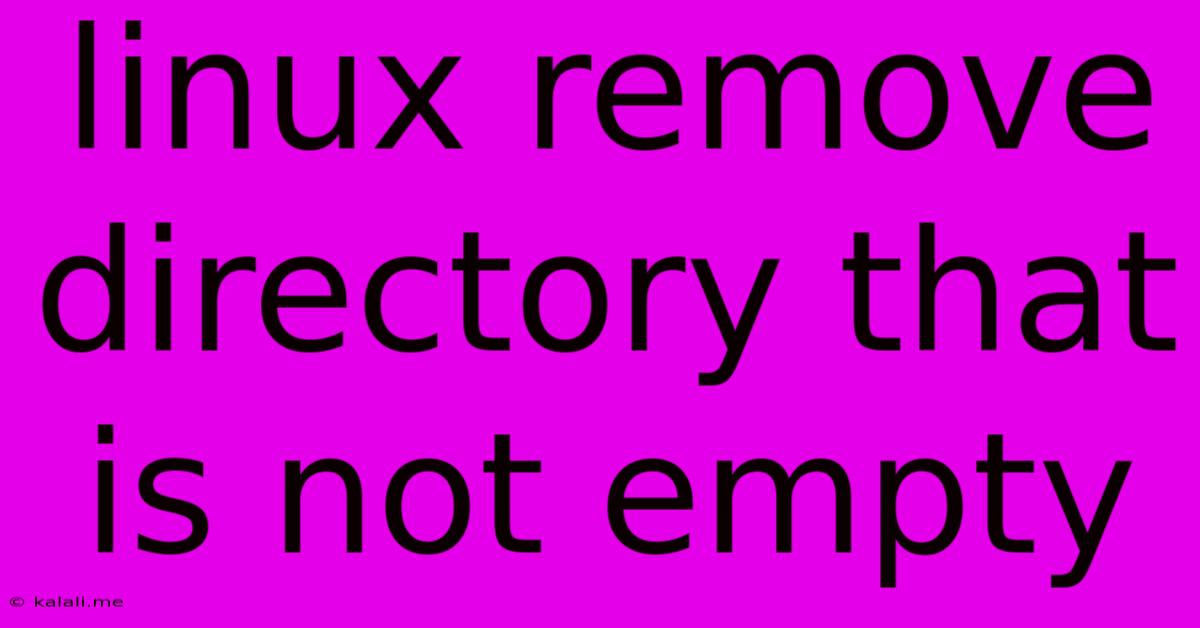Linux Remove Directory That Is Not Empty
Kalali
May 21, 2025 · 3 min read

Table of Contents
Removing Non-Empty Directories in Linux: A Comprehensive Guide
This guide provides a comprehensive overview of how to remove non-empty directories in Linux, covering various commands and their nuances. Knowing how to safely and efficiently delete directories is a crucial skill for any Linux user. This article covers different approaches, highlighting the advantages and disadvantages of each method, ensuring you choose the right tool for the job. We will explore using the rm command with its various options, and the more interactive rmdir command.
Understanding the Challenge: Why Simply rm Doesn't Always Work
The simple rm command (remove) is insufficient for deleting non-empty directories. Attempting rm -r directory_name might seem like the solution, but understanding its implications is crucial. This command, while effective, lacks interactivity and can permanently delete data without confirmation. Accidental deletion can lead to significant data loss, particularly if the directory contains valuable files or projects.
Safe and Effective Methods for Directory Removal
Several methods exist for safely removing non-empty directories in Linux, each with its own advantages and disadvantages. Choosing the right approach depends on your comfort level with the command line and the level of caution you need.
1. rm -rf directory_name (Force Removal):
This command is the most aggressive. The -r (recursive) flag instructs the command to remove directories and their contents recursively, while -f (force) prevents prompts and confirmations. Use this command with extreme caution, as it permanently deletes everything within the directory without any chance for recovery. It's best suited for situations where you're absolutely certain you want to delete the directory and its contents. Consider this a last resort.
2. rm -r directory_name (Recursive Removal with Confirmation):
This command is similar to the previous one but omits the -f flag. This means the system will prompt you for confirmation before deleting each file and directory within the target directory. This provides a safety net, allowing you to review the files and folders before deletion. This is a safer alternative to the forceful removal but can still be time-consuming for large directories.
3. Interactive Removal using find and xargs:
For a more controlled and selective removal, you can combine find and xargs. This approach allows you to preview the files and directories before deletion.
find directory_name -type f -print0 | xargs -0 ls -l
This command first locates all files (-type f) within the specified directory and prints their names separated by null characters (-print0). Then, xargs -0 takes this null-separated list and passes it to ls -l, which displays a long listing of the files, showing their permissions, size, and modification times. This allows for a thorough review before proceeding with deletion. Once you've confirmed the contents, you can proceed with deletion:
find directory_name -type f -delete
Remember to replace directory_name with the actual name of your directory. This method offers more control and allows for verification before deleting files, making it safer than rm -rf.
4. Removing Empty Directories with rmdir:
The rmdir command is designed specifically for removing empty directories. It will not work on directories containing files or subdirectories. This command is simple and safe, as it prevents accidental deletion of files.
rmdir directory_name
Best Practices and Safety Tips
- Always back up important data: Before attempting any directory removal, especially using
rm -rf, ensure you have a backup of your valuable files. - Double-check the directory path: Carefully verify the directory path to avoid accidentally deleting the wrong directory.
- Use interactive methods whenever possible: Opt for methods like
rm -ror thefindandxargscombination for enhanced safety and control. - Start with a test: If you're unsure, try the commands on a test directory first to avoid unexpected data loss.
- Understand the flags: Familiarize yourself with the different flags used with
rmand other commands to avoid unintended consequences.
By understanding the nuances of each method and following these best practices, you can confidently remove non-empty directories in Linux while minimizing the risk of data loss. Remember, prevention is always better than cure—regular backups are essential for protecting your valuable data.
Latest Posts
Latest Posts
-
How Many Days Is In 11 Weeks
Jul 14, 2025
-
How Many Grams Are In One Tola Gold
Jul 14, 2025
-
How Many Oz In A Pound Of Freon
Jul 14, 2025
-
How Many Years Are In A Millennia
Jul 14, 2025
-
Words With C As The Second Letter
Jul 14, 2025
Related Post
Thank you for visiting our website which covers about Linux Remove Directory That Is Not Empty . We hope the information provided has been useful to you. Feel free to contact us if you have any questions or need further assistance. See you next time and don't miss to bookmark.